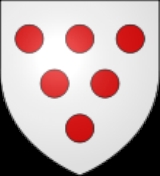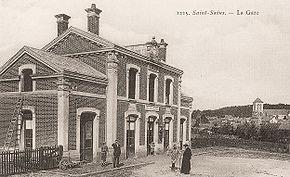
Saint-Saëns, Seine-Maritime
Encyclopedia
Saint-Saëns is a commune
in the Seine-Maritime
department in the Haute-Normandie
region in northern France
.
situated by the banks of the Varenne River
in the Pays de Bray
, some 19 miles (30.6 km) southeast of Dieppe
at the junction of the D929, D12, D99 and the D154 roads. Junction 11 of the A28 autoroute
with the A29 autoroute
is within the commune’s territory.
, an Irish monk and a disciple of St. Philibert of Jumièges
. Sidonius died in about 689 and was buried in the monastery.
Called "Sancti Sidonii" city around 830, it was destroyed by the Vikings in the 9th century.
In the 11th century, the lords of Saint-Saens were rich and powerful men. One of them became governor of Rouen and another excelled at the Battle of Hastings
. They built again on Cateliers hill, this time a castle and a collegiate church
which later became the Benedictine
abbey of Saint-Wandrille.
In 1127, one Hélie of Saint-Saens was outlawed in England on the orders of Henry I of England
for sheltering Guillaume Cliton, rebel claimant to the duchy
of Normandy.
The castle was taken in 1204 by King Philip II Augustus and became part of France, like most of Normandy by this time.
In the middle of the twelfth century, a Bernardines convent
was founded by Empress Matilda
near the village. This was later upgraded to an abbey
in 1629. The abbess was a friend of Madame de Maintenon, who often contributed to the beautification of the church.
The castle and village were looted and burned by the English and the Burgundians in 1450 and again by Henry IV of France
in 1592. That same year, the Spanish ravaged the manor of Quesnay.
In the 14th century, the town was famous for its draper
s, blacksmith
s, potters
and cutlery
. Glassmaking started here in 1450 at the hamlet of Bully and was active until 1807. The tanneries
were well-known up until the 19th century. By 1740, there was only one monk left at the monastery and after the Revolution it became the present-day church.

Communes of France
The commune is the lowest level of administrative division in the French Republic. French communes are roughly equivalent to incorporated municipalities or villages in the United States or Gemeinden in Germany...
in the Seine-Maritime
Seine-Maritime
Seine-Maritime is a French department in the Haute-Normandie region in northern France. It is situated on the northern coast of France, at the mouth of the Seine, and includes the cities of Rouen and Le Havre...
department in the Haute-Normandie
Haute-Normandie
Upper Normandy is one of the 27 regions of France. It was created in 1984 from two départements: Seine-Maritime and Eure, when Normandy was divided into Lower Normandy and Upper Normandy. This division continues to provoke controversy, and some continue to call for reuniting the two regions...
region in northern France
France
The French Republic , The French Republic , The French Republic , (commonly known as France , is a unitary semi-presidential republic in Western Europe with several overseas territories and islands located on other continents and in the Indian, Pacific, and Atlantic oceans. Metropolitan France...
.
Geography
A small town of farming and associated light industryLight industry
Light industry is usually less capital intensive than heavy industry, and is more consumer-oriented than business-oriented...
situated by the banks of the Varenne River
Varenne River
The Varenne is a river of Normandy, France, in length, flowing through the department of Seine-Maritime and it is a tributary of the Arques River.- Geography :...
in the Pays de Bray
Pays de Bray
The Pays de Bray is a small natural region of France situated to the north-east of Rouen, straddling the French départements of the Seine-Maritime and Oise...
, some 19 miles (30.6 km) southeast of Dieppe
Dieppe, Seine-Maritime
Dieppe is a commune in the Seine-Maritime department in France. In 1999, the population of the whole Dieppe urban area was 81,419.A port on the English Channel, famous for its scallops, and with a regular ferry service from the Gare Maritime to Newhaven in England, Dieppe also has a popular pebbled...
at the junction of the D929, D12, D99 and the D154 roads. Junction 11 of the A28 autoroute
A28 autoroute
Autoroute 28 is an motorway linking Abbeville in Somme to Tours in Indre-et-Loire.The motorway starts at Abbeville splitting from the A16 and, after merging with the A13 near Rouen, ends at Tours, merging with the A10. The motorway between Rouen and Tours was added to the Schéma Directeur Routier...
with the A29 autoroute
A29 autoroute
The A29 is a motorway in Normandy, northern France. The road is also European Route 44.-Route:The road connects the port of Le Havre with the A26 autoroute at Saint-Quentin...
is within the commune’s territory.
History
The year 674 saw the foundation of a monastery on Cateliers hill at the present-day location of the village. The first abbot was Sidonius of Saint-SaënsSidonius of Saint-Saëns
Sidonius was an Irish-born French monk and saint. He was the spiritual teacher of Leutfridus.Sidonus was born sometime in the seventh century, and was a monk at the abbey in Jumieges in 664; he then spent several years travelling between monasteries. For ten years he served in Rome as a companion...
, an Irish monk and a disciple of St. Philibert of Jumièges
Philibert of Jumièges
Saint Philibert of Jumièges was an abbot and monastic founder, particularly associated with Jumièges Abbey.He was born in Gascony as the only son of a Vic or Vic-Jour based courtier of Dagobert I and was educated by Saint Ouen...
. Sidonius died in about 689 and was buried in the monastery.
Called "Sancti Sidonii" city around 830, it was destroyed by the Vikings in the 9th century.
In the 11th century, the lords of Saint-Saens were rich and powerful men. One of them became governor of Rouen and another excelled at the Battle of Hastings
Battle of Hastings
The Battle of Hastings occurred on 14 October 1066 during the Norman conquest of England, between the Norman-French army of Duke William II of Normandy and the English army under King Harold II...
. They built again on Cateliers hill, this time a castle and a collegiate church
Collegiate church
In Christianity, a collegiate church is a church where the daily office of worship is maintained by a college of canons; a non-monastic, or "secular" community of clergy, organised as a self-governing corporate body, which may be presided over by a dean or provost...
which later became the Benedictine
Benedictine
Benedictine refers to the spirituality and consecrated life in accordance with the Rule of St Benedict, written by Benedict of Nursia in the sixth century for the cenobitic communities he founded in central Italy. The most notable of these is Monte Cassino, the first monastery founded by Benedict...
abbey of Saint-Wandrille.
In 1127, one Hélie of Saint-Saens was outlawed in England on the orders of Henry I of England
Henry I of England
Henry I was the fourth son of William I of England. He succeeded his elder brother William II as King of England in 1100 and defeated his eldest brother, Robert Curthose, to become Duke of Normandy in 1106...
for sheltering Guillaume Cliton, rebel claimant to the duchy
Duchy
A duchy is a territory, fief, or domain ruled by a duke or duchess.Some duchies were sovereign in areas that would become unified realms only during the Modern era . In contrast, others were subordinate districts of those kingdoms that unified either partially or completely during the Medieval era...
of Normandy.
The castle was taken in 1204 by King Philip II Augustus and became part of France, like most of Normandy by this time.
In the middle of the twelfth century, a Bernardines convent
Convent
A convent is either a community of priests, religious brothers, religious sisters, or nuns, or the building used by the community, particularly in the Roman Catholic Church and in the Anglican Communion...
was founded by Empress Matilda
Empress Matilda
Empress Matilda , also known as Matilda of England or Maude, was the daughter and heir of King Henry I of England. Matilda and her younger brother, William Adelin, were the only legitimate children of King Henry to survive to adulthood...
near the village. This was later upgraded to an abbey
Abbey
An abbey is a Catholic monastery or convent, under the authority of an Abbot or an Abbess, who serves as the spiritual father or mother of the community.The term can also refer to an establishment which has long ceased to function as an abbey,...
in 1629. The abbess was a friend of Madame de Maintenon, who often contributed to the beautification of the church.
The castle and village were looted and burned by the English and the Burgundians in 1450 and again by Henry IV of France
Henry IV of France
Henry IV , Henri-Quatre, was King of France from 1589 to 1610 and King of Navarre from 1572 to 1610. He was the first monarch of the Bourbon branch of the Capetian dynasty in France....
in 1592. That same year, the Spanish ravaged the manor of Quesnay.
In the 14th century, the town was famous for its draper
Draper
Draper is the now largely obsolete term for a wholesaler, or especially retailer, of cloth, mainly for clothing, or one who works in a draper's shop. A draper may additionally operate as a cloth merchant or a haberdasher. The drapers were an important trade guild...
s, blacksmith
Blacksmith
A blacksmith is a person who creates objects from wrought iron or steel by forging the metal; that is, by using tools to hammer, bend, and cut...
s, potters
Pottery
Pottery is the material from which the potteryware is made, of which major types include earthenware, stoneware and porcelain. The place where such wares are made is also called a pottery . Pottery also refers to the art or craft of the potter or the manufacture of pottery...
and cutlery
Cutlery
Cutlery refers to any hand implement used in preparing, serving, and especially eating food in the Western world. It is more usually known as silverware or flatware in the United States, where cutlery can have the more specific meaning of knives and other cutting instruments. This is probably the...
. Glassmaking started here in 1450 at the hamlet of Bully and was active until 1807. The tanneries
Tanning
Tanning is the making of leather from the skins of animals which does not easily decompose. Traditionally, tanning used tannin, an acidic chemical compound from which the tanning process draws its name . Coloring may occur during tanning...
were well-known up until the 19th century. By 1740, there was only one monk left at the monastery and after the Revolution it became the present-day church.
Heraldry
Population
Main sights

- The church of St. Saëns, dating from the thirteenth century.
- Ruins of the twelfth-century castle.
- The manorhouse at the hamlet of Quesnay.
- Two chateaus, at Bailly and Vaudichon.
- The seventeenth century market building.
- Vestiges of the seventeenth-century Bernardines convent.

